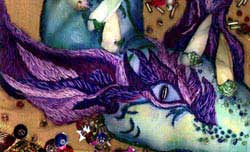Split stitch
I have had requests for a more detailed view of this dragon. Click on the image to see him in all his glory. It is a large graphic so please be patient.
![]() Split stitch is also known as Kensington outline stitch. Since split stitch follows curves well it is used for outlines. It is also extremely effective worked solidly as a shaded filling. Worked solidly it can create a brush-stroke quality in embroidery. It is an easy stitch to master, quick to work and produces effective results.
Split stitch is also known as Kensington outline stitch. Since split stitch follows curves well it is used for outlines. It is also extremely effective worked solidly as a shaded filling. Worked solidly it can create a brush-stroke quality in embroidery. It is an easy stitch to master, quick to work and produces effective results.
It was used during the Middle Ages for embroidering figures. Split stitch became one of the preferred stitches of the embroiderers of 'opus anglicanum' where it is worked on a fine scale in a dense manner following the contours of features making the modelling of faces and hands very life like.

To work this stitch successfully you need to use a thread that is soft and can easily be split by the needle. Tapestry wool, crewel wool, stranded cotton embroidery floss is ideal for this type of work.
Working this stitch is similar to stem stitch but in the case of split stitch the thread is split by the needle as it emerges from the fabric. Work from left to right taking small regular stitches with a forwards and backwards motion along the line of the design. The completed stitch can look a little like chain stitch.

